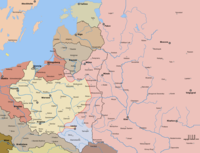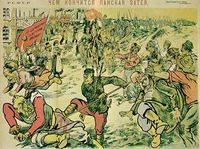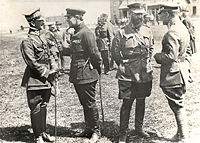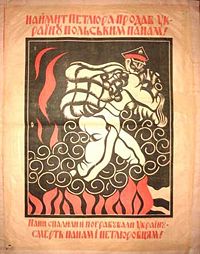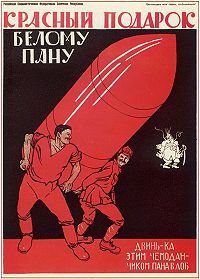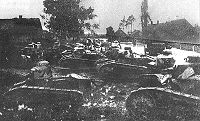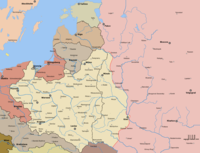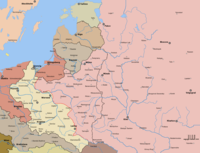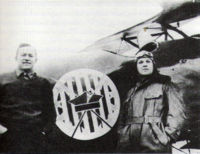Polish-Soviet War
2008/9 Schools Wikipedia Selection. Related subjects: Military History and War
| Polish-Soviet War | |||||||
|---|---|---|---|---|---|---|---|
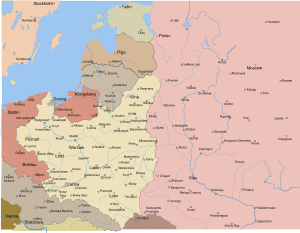 The final borders layout settled by the war. |
|||||||
|
|||||||
| Belligerents | |||||||
| Commanders | |||||||
| Leon Trotsky Mikhail Tukhachevsky (Western Front) Aleksandr Yegorov (Southwestern Front) Semyon Budyonny 1st Cavalry Army |
|||||||
| Strength | |||||||
| From ~50,000 in early 1919 to almost 800,000 in summer 1920 | From ~50,000 in early 1919 to ~738,000 in August 1920 | ||||||
| Casualties and losses | |||||||
| Unknown 80,000 taken prisoner (including rear-area personnel) |
47,571 killed -96,250 113,518 wounded, 51,351 taken prisoner |
||||||
|
|||||
|
|||||
|
|||||
The Polish-Soviet War (February 1919 – March 1921) was an armed conflict of Soviet Russia and Soviet Ukraine against the Second Polish Republic and the short-lived Ukrainian People's Republic, four states in post-World War I Europe. The war was the result of conflicting expansionist attempts. Poland, whose statehood had just been re-established by the Treaty of Versailles following the Partitions of Poland in the late 18th century, sought to secure territories which she had lost at the time of partitions; the Soviets' aim was to control those same territories, which had been part of Imperial Russia until the turbulent events of the Great War. Both States claimed victory in the war: the Poles claimed a successful defense of their state, while the Soviets claimed a repulse of the Polish eastward invasion of Ukraine and Belarus, which they viewed as a part of foreign intervention in the Russian Civil War.
The frontiers between Poland and Soviet Russia had not been defined in the Treaty of Versailles and post-war events created turmoil: the Russian Revolution of 1917; the crumbling of the Russian, German and Austrian empires; the Russian Civil War; the Central Powers' withdrawal from the eastern front; and the attempts of Ukraine and Belarus to establish their independence. Poland's Chief of State, Józef Piłsudski, felt the time expedient to expand Polish borders as far east as feasible, to be followed by the creation of a Polish-led federation ( Międzymorze) of several states in the rest of East-Central Europe as a bulwark against the potential re-emergence of both German and Russian imperialism. Lenin, meanwhile, saw Poland as the bridge that the Red Army would have to cross in order to assist other communist movements and help conduct other European revolutions.
By 1919, the Polish forces had taken control of much of Western Ukraine, with victory in the Polish-Ukrainian War; the West Ukrainian People's Republic had tried unsuccessfully to create a Ukrainian state on territories to which both Poles and the Ukrainians laid claim. At the same time, the Bolsheviks began to gain the upper hand in the Russian Civil War and advance westward towards the disputed territories. By the end of 1919 a clear front had formed. Border skirmishes escalated into open warfare following Piłsudski's major incursion further east into Ukraine in April 1920. He was met by a nearly simultaneous and initially very successful Red Army counterattack. The Soviet operation threw the Polish forces back westward all the way to the Polish capital, Warsaw. Meanwhile, western fears of Soviet troops arriving at the German frontiers increased the interest of Western powers in the war. In midsummer, the fall of Warsaw seemed certain but in mid-August the tide had turned again as the Polish forces achieved an unexpected and decisive victory at the Battle of Warsaw. In the wake of the Polish advance eastward, the Soviets sued for peace and the war ended with a ceasefire in October 1920. A formal peace treaty, the Peace of Riga, was signed on 18 March 1921, dividing the disputed territories between Poland and Soviet Russia. The war largely determined the Soviet-Polish border for the period between the World Wars. Much of the territory ceded to Poland in the Treaty of Riga became part of the Soviet Union after World War II, when Poland's eastern borders were redefined by the Allies in close accordance with the British-drawn Curzon Line of 1920.
Names and dates
The war is referred to by several names. "Polish-Soviet War" may be the most common, but is potentially confusing since "Soviet" is usually thought of as relating to the Soviet Union, which (by contrast with " Soviet Russia") did not officially come into being until December 1922. Alternative names include "Russo-Polish War [or Polish-Russian War] of 1919–20/21" (to distinguish it from earlier Polish-Russian wars) and "Polish-Bolshevik War". This second term (or just "Bolshevik War" ( Polish: Wojna bolszewicka)) is most common in Polish sources. In some Polish sources it is also referred as the "War of 1920" (Polish: Wojna 1920 roku).
Other points of contention are the starting and ending dates of the war. For example, Encyclopedia Britannica begins its article with the date (1919–1920), but then says "Although there had been hostilities between the two countries during 1919, the conflict began when the Polish head of state Józef Pilsudski formed an alliance with the Ukrainian nationalist leader Symon Petlyura (April 21, 1920) and their combined forces began to overrun Ukraine, occupying Kiev on May 7." while the Polish Internetowa encyklopedia PWN as well as some historians—like Norman Davies—clearly consider 1919 as the starting year of the war. The ending date is given as either 1920 or 1921; this confusion stems from the fact that while the ceasefire was put in force in fall 1920, the official treaty ending the war was signed months later, in March 1921.
While the events of 1919 can be described as a border conflict and only in early 1920 did both sides realize that they were in fact engaged in an all-out war, the conflicts that took place in 1919 are closely related to the war that began in earnest a year later. In the end, the events of 1920 were only a logical, though unforeseen, consequence of the 1919 prelude.
Prelude
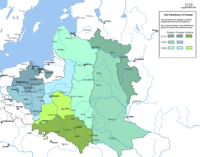
In the aftermath of World War I, the map of Central and Eastern Europe had drastically changed. Germany's defeat rendered its plans for the creation of Eastern European puppet states ( Mitteleuropa) obsolete, and Russia saw its Empire collapse followed by a descent into Revolution and Civil War. Many small nations of the region saw a chance for real independence and were not prepared to relinquish the opportunity; Soviet Russia viewed these territories as rebellious Russian provinces, vital for Russian security, but was unable to react swiftly.
With the success of the Greater Poland Uprising in 1918, Poland had re-established its statehood for the first time since the 1795 partition and seen the end of a 123 years of rule by three imperial neighbors: Russia, Germany, and Austria-Hungary. The country, reborn as a Second Polish Republic, proceeded to carve out its borders from the territories of its former partitioners.
Poland was not alone in its newfound opportunities and troubles. Virtually all of the newly independent neighbours began fighting over borders: Romania fought with Hungary over Transylvania, Yugoslavia with Italy over Rijeka, Poland with Czechoslovakia over Cieszyn Silesia, with Germany over Poznań and with Ukrainians over Eastern Galicia. Ukrainians, Belarusians, Lithuanians, Estonians and Latvians fought against each other and against the Russians, who were just as divided. Spreading communist influences resulted in communist revolutions in Munich, Berlin, Budapest and Prešov. Winston Churchill commented: "The war of giants has ended, the wars of the pygmies begin." All of those engagements – with the sole exception of the Polish-Soviet war – would be shortlived conflicts.
The Polish-Soviet war likely happened more by accident than design, as it is unlikely that anyone in Soviet Russia or in the new Second Republic of Poland would have deliberately planned a major foreign war. Poland, its territory a major frontline of the First World War, was unstable politically; it had just won the difficult conflict with the West Ukrainian National Republic and was already engaged in new conflicts with Germany (the Silesian Uprisings) and with Czechoslovakia. The attention of revolutionary Russia, meanwhile, was predominantly directed at thwarting counter-revolution and intervention by the western powers. While the first clashes between Polish and Soviet forces occurred in February 1919, it would be almost a year before both sides realised that they were engaged in a full war.
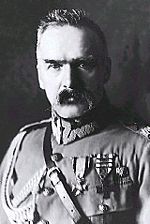
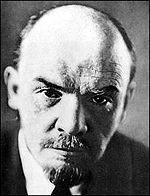
In late 1919 the leader of Russia's new communist government, Vladimir Lenin, was inspired by the Red Army's civil-war victories over White Russian anti-communist forces and their western allies, and began to see the future of the revolution with greater optimism. The Bolsheviks proclaimed the need for the dictatorship of the proletariat, and agitated for a worldwide communist community. Their avowed intent was to link the revolution in Russia with an expected revolution in Germany and to assist other communist movements in Western Europe; Poland was the geographical bridge that the Red Army would have to cross in order to do so. Lenin’s aim was to restore control of the territories ceded by Russia in the Brest-Litovsk Treaty, to infiltrate the borderlands, set up soviet governments there as well as in Poland, and reach Germany where he expected a socialist revolution to break out. He believed that Soviet Russia could not survive without the support of a socialist Germany. By the end of summer 1919 the Soviets managed to take over most of Ukraine, driving the Ukrainian government from Kiev. In early 1919, they also set up a Lithuanian-Belorussian Republic (Litbel). This government was very unpopular due to terror and the collection of food and goods for the army. It was not until after the Kiev Offensive had been repelled, however, that some of the Soviet leaders would see the war as the real opportunity to spread the revolution westwards. Indeed, the Bolsheviks stated:
| “ | But our enemies and yours deceive you when they say that the Russian Soviet Government wishes to plant communism in Polish soil with the bayonets of Russian Red Army men. A communist order is possible only where the vast majority of the working people are penetrated with the idea of creating it by their own strength. Only then can it be solid; for only then can communist policy strike deep roots in a country. The communists of Russia are at present striving only to defend their own soil, their own constructive work; they are not striving, and cannot strive, to plant communism by force in other countries.” | ” |
Before the start of the Polish-Soviet War Polish politics were strongly influenced by Chief of State ( naczelnik państwa) Józef Piłsudski. Piłsudski wanted to break the Russian Empire and create a Polish-led " Międzymorze Federation" of independent states: Poland, Lithuania, Ukraine, and other Central and East European countries emerging out of crumbling empires after the First World War. This new union was to become a counterweight to any potential imperialist intentions on the part of Russia or Germany. Piłsudski argued that "There can be no independent Poland without an independent Ukraine", but he may have been more interested in Ukraine being split from Russia than in Ukrainians' welfare. He did not hesitate to use military force to expand the Polish borders to Galicia and Volhynia, crushing a Ukrainian attempt at self-determination in the disputed territories east of the Western Bug river, which contained a significant Polish minority, mainly in cities like Lwów (Lviv), but a Ukrainian majority in the countryside. Speaking of Poland's future frontiers, Piłsudski said: "All that we can gain in the west depends on the Entente—on the extent to which it may wish to squeeze Germany," while in the east "there are doors that open and close, and it depends on who forces them open and how far." In the chaos to the east the Polish forces set out to expand there as much as it was feasible. On the other hand, Poland had no intention of joining the western intervention in the Russian Civil War or of conquering Russia itself.
Course
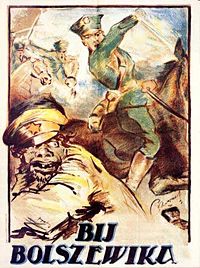
1919
Chaos in Eastern Europe
In 1918 the German Army in the east, under the command of Max Hoffmann, began to retreat westwards. The territories abandoned by the Central Powers (Germany, Austria-Hungary, the Ottoman Empire, and Bulgaria) became a field of conflict among local governments created by Germany, other local governments that independently sprang up after the German retreat, and the Bolsheviks, who hoped to incorporate those areas into Soviet Russia. As a result, almost all of Eastern Europe was in chaos.
On November 18, 1918, the Soviet Supreme Command issued orders to the Western Army of the Red Army to begin a westward movement that would follow the withdrawing German troops of Oberkommando Ostfront ( Ober-Ost). The basic aim was to secure as much territory as possible with the few resources locally available.
At the start of 1919, Polish-Soviet fighting broke out almost by accident and without any orders from the respective governments when self-organized Polish military units in Vilnius (Wilno) clashed with Bolshevik forces of Litbel, each trying to secure the territories for its own incipient government. Eventually the more organized Soviet forces quelled most of the resistance and drove the remaining Polish forces west. On January 5, 1919, the Red Army entered Minsk almost unopposed, thus putting an end to the short-lived Belarusian People's Republic. At the same time, more and more Polish self-defense units sprang up across western Belarus and Lithuania (such as the Lithuanian and Belarusian Self-Defence). and engaged in a series of local skirmishes with pro-Bolshevik groups operating in the area. The newly organized Polish Army began sending the first of their units east to assist the self-defense forces, while the Soviets sent their own units west.
In the spring of 1919, Soviet conscription produced a Red Army of 2,300,000. Few of these were sent west that year, as the majority of Red Army forces were engaged against the Russian White movement; the Western Army in February 1919 had just 46,000 men. In February 1919, the entire Polish army numbered 110,000 men; in April, 170,000, including 80,000 combatants while by September 1919, it had 540,000 men; 230,000 of these were on the Soviet front.
By 14 February, the Poles, who had been advancing eastwards, secured positions along the line of Kobryn, Pruzhany, and the rivers Zalewianka and Neman. Around 14 February, at Mosty, the first organised Polish units made contact with the advance units of the Red Army. Bolshevik units withdrew without a shot. A frontline slowly began to form from Lithuania, through Belarus to Ukraine.
First Polish-Soviet conflicts
The first serious armed conflict of the war took place around February 14 - February 16, near the towns of Maniewicze and Biaroza in Belarus. By late February the Soviet advance had come to a halt. Both Polish and Soviet forces had also been engaging the Ukrainian forces, and active fighting was going on in the territories of the Baltic countries (cf. Estonian Liberation War, Latvian War of Independence, Freedom wars of Lithuania).
In early March 1919, Polish units started an offensive, crossing the Neman River, taking Pinsk, and reaching the outskirts of Lida. Both the Soviet and Polish advances began around the same time in April (Polish forces started a major offensive on April 16), resulting in increasing numbers of troops arriving in the area. That month the Bolsheviks captured Grodno, but soon were pushed out by a Polish counteroffensive. Unable to accomplish their objectives and facing strengthening offensives from the White forces, the Red Army withdrew from their positions and reorganized. Soon the Polish-Soviet War would begin in earnest.
Polish forces continued a steady eastern advance. They took Lida on April 17 and Nowogródek on April 18, and recaptured Vilnius on April 19, driving the Litbel government from their proclaimed capital. On August 8, Polish forces took Minsk and on the 28th of that month they deployed tanks for the first time. After heavy fighting, the town of Babruysk near the Berezina River was captured. By October 2, Polish forces reached the Daugava river and secured the region from Desna to Daugavpils (Dyneburg).
Polish success continued until early 1920. Sporadic battles erupted between Polish forces and the Red Army, but the latter was preoccupied with the White counter-revolutionary forces and was steadily retreating on the entire western frontline, from Latvia in the north to Ukraine in the south. In early summer 1919, the White movement had gained the initiative, and its forces under the command of Anton Denikin were marching on Moscow. Piłsudski was aware that the Soviets were not friends of independent Poland, and considered the that war with Soviet Russia inevitable. He viewed their advance west as a major issue but also thought that he could get a better deal for Poland from the Bolsheviks than their Russian-civil-war contenders, as the White Russians - representative of the old Russian Empire, partitioner of Poland - were willing to accept only limited independence of Poland, likely in the borders similar to that of Congress Poland, and clearly objected to Ukrainian independence, crucial for Piłsudski's Międzymorze, while the Bolsheviks did proclaim the partitions null and void. Piłsudski thus speculated that Poland will be better of with the Bolsheviks, alienated from the Western powers, than with restored Russian Empire. By his refusal to join the attack on Lenin's struggling government, ignoring the strong pressure from the Entente, Piłsudski had likely saved the Bolshevik government in Summer–Fall 1919. He later wrote that in case of a White victory, in the east Poland could only gain the "ethnic border" at best (the Curzon line). At the same time Lenin offered Poles the territories of Minsk, Zhytomyr, Khmelnytskyi, in what was described as mini " Brest"; Polish military leader Kazimierz Sosnkowski wrote that the territorial proposals of the Bolsheviks were much better than what the Poles had wanted to achieve.
Diplomatic Front, Part 1: The alliances
In 1919, several unsuccessful attempts at peace negotiations were made by various Polish and Russian factions. In the meantime, Polish-Lithuanian relations worsened as Polish politicians found it hard to accept the Lithuanians' demands for independence and territories, especially on ceding the city of Vilnius (Wilno), Lithuania's historical capital which had a Polish ethnic majority. Polish negotiators made better progress with the Latvian Provisional Government, and in late 1919 and early 1920 Polish and Latvian forces were conducting joint operations against Soviet Russia.
The Warsaw Treaty, an agreement with the exiled Ukrainian nationalist leader Symon Petlura signed on April 21, 1920, was the main Polish diplomatic success. Petlura, who formally represented the government of the Ukrainian People's Republic (by then de facto defeated by Bolsheviks), along with some Ukrainian forces, fled to Poland, where he found asylum. His control extended only to a sliver of land near the Polish border. In such conditions, there was little difficulty convincing Petlura to join an alliance with Poland, despite recent conflict between the two nations that had been settled in favour of Poland. By concluding an agreement with Piłsudski, Petlura accepted the Polish territorial gains in Western Ukraine and the future Polish-Ukrainian border along the Zbruch River. In exchange, he was promised independence for Ukraine and Polish military assistance in reinstalling his government in Kiev.
For Piłsudski, this alliance gave his campaign for the Międzymorze federation the legitimacy of joint international effort, secured part of the Polish eastward border, and laid a foundation for a Polish dominated Ukrainian state between Russia and Poland. For Petlura, this was a final chance to preserve the statehood and, at least, the theoretical independence of the Ukrainian heartlands, even while accepting the loss of Western Ukrainian lands to Poland.
Yet both of them were opposed at home. Piłsudski faced stiff opposition from Dmowski's National Democrats who opposed Ukrainian independence. Petlura, in turn, was criticized by many Ukrainian politicians for entering a pact with the Poles and giving up on Western Ukraine.
The alliance with Petliura did result in 15,000 pro-Polish allied Ukrainian troops at the beginning of the campaign, increasing to 35,000 through recruitment and desertion from the Soviet side during the war. But in the end, this would prove too few to support Petlura's hopes for independent Ukraine, or Piłsudski's dreams of the Ukrainian ally in the Międzymorze federation.
1920
Opposing forces
Norman Davies notes that estimating strength of the opposing sides is very tricky; even generals often had incomplete reports of their own forces.
By early 1920, the Red Army had been very successful against the White armies. They defeated Denikin and signed peace treaties with Latvia and Estonia. The Polish front became their most important war theatre and a plurality of Soviet resources and forces were diverted to it. In January 1920, the Red Army began concentrating a 700,000-strong force near the Berezina River and on Belarus.
By the time Poles launched their Kiev offensive, The Red Southwestern Front had about 82,847 soldiers including 28,568 front-line troops. The Poles had some numerical superiority, estimated from 12,000 to 52,000 personnel. By the time of the Soviet counter-offensive in mid 1920 the situation had been reversed: Soviets had about 790,000 people - at least 50,000 or more than the Poles; Tukhachevsky estimated that he had 160,000 "combat-ready" soldiers; Piłsudski estimated enemy's forces at 200,000–220,000.
In the course of 1920, almost 800,000 Red Army personnel were sent to fight in the Polish war, of whom 402,000 went to the Western front and 355,000 to the armies of the South-West front in Galicia. Grigoriy Krivosheev gives similar numbers, with 382,000 personnel for Western Fron and 283,000 personnel for Southwestern Front.
Norman Davies shows the growth of Red Army forces in the Polish front in early 1920:
-
- 1 January 1920 - 4 infantry divisions, 1 cavalry brigade
- 1 February 1920 - 5 infantry divisions, 5 cavalry brigades
- 1 March 1920 - 8 infantry divisions, 4 cavalry brigades
- 1 April 1920 - 14 infantry divisions, 3 cavalry brigades
- 15 April 1920 - 16 infantry divisions, 3 cavalry brigades
- 25 April 1920 - 20 infantry divisions, 5 cavalry brigades
- 1 February 1920 - 5 infantry divisions, 5 cavalry brigades
- 1 January 1920 - 4 infantry divisions, 1 cavalry brigade
Bolshevik commanders in the Red Army's coming offensive would include Leon Trotsky, Mikhail Tukhachevsky (new commander of the Western Front), Aleksandr Yegorov (new commander of the Southwestern Front), the future Soviet ruler Joseph Stalin, and the founder of the Cheka (secret police), Felix Edmundovich Dzerzhinsky.
The Polish Army was made up of soldiers who had formerly served in the various partitioning empires, supported by some international volunteers, such as the Kościuszko Squadron. Boris Savinkov was at the head of an army of 20,000 to 30,000 largely Russian POWs, and was accompanied by Dmitry Merezhkovsky and Zinaida Gippius. The Polish forces grew from approximately 100,000 in 1918 to over 500,000 in early 1920. In August, 1920, the Polish army had reached a total strength of 737,767 people; half of that was on the frontline. Given Soviet losses, there was rough numerical parity between the two armies; and by the time of the battle of Warsaw Poles might have even had a slight advantage in numbers and logistics.
Logistics, nonetheless, were very bad for both armies, supported by whatever equipment was left over from World War I or could be captured. The Polish Army, for example, employed guns made in five countries, and rifles manufactured in six, each using different ammunition. The Soviets had many military depots at their disposal, left by withdrawing German armies in 1918–19, and modern French armaments captured in great numbers from the White Russians and the Allied expeditionary forces in the Russian Civil War. Still, they suffered a shortage of arms; both the Red Army and the Polish forces were grossly underequipped by Western standards.
The Soviet High Command planned a new offensive in late April/May. Since March 1919, Polish intelligence was aware that the Soviets had prepared for a new offensive and the Polish High Command decided to launch their own offensive before their opponents. The plan for Operation Kiev was to beat the Red Army on Poland's southern flank and install a Polish-friendly Petlura government in Ukraine.
The tide turns: Operation Kiev
Until April, the Polish forces had been slowly but steadily advancing eastward. The new Latvian government requested and obtained Polish help in capturing Daugavpils. The city fell after heavy fighting in January and was handed over to the Latvians, who viewed the Poles as liberators. By March, Polish forces had driven a wedge between Soviet forces to the north (Byelorussia) and south (Ukraine).
On April 24, Poland began its main offensive, Operation Kiev. Its goal was the creation of independent Ukraine that would become part of Piłsudski's project of a " Międzymorze" Federation. Poland's forces were assisted by 15,000 Ukrainian soldiers under Symon Petlura, representing the Ukrainian People's Republic.
On April 26, in his "Call to the People of Ukraine", Piłsudski assured that "the Polish army would only stay as long as necessary until a legal Ukrainian government took control over its own territory". Despite this, many Ukrainians were just as anti-Polish as anti-Bolshevik, and resented the Polish advance.
The Polish 3rd Army easily won border clashes with the Red Army in Ukraine but the Reds withdrew with minimal losses. The combined Polish-Ukrainian forces entered an abandoned Kiev on May 7, encountering only token resistance.
The Polish military thrust was met with Red Army counterattacks on 29 May. Polish forces in the area, preparing for an offensive towards Zhlobin, managed to push the Soviets back, but were unable to start their own planned offensive. In the north, Polish forces had fared much worse. The Polish 1st Army was defeated and forced to retreat, pursued by the Russian 15th Army which recaptured territories between the Western Dvina and Berezina rivers. Polish forces attempted to take advantage of the exposed flanks of the attackers but the enveloping forces failed to stop the Soviet advance. At the end of May, the front had stabilised near the small river Auta, and Soviet forces began preparing for the next push.
On May 24 1920, the Polish forces in the south were engaged for the first time by Semyon Budionny's famous 1st Cavalry Army (Konarmia). Repeated attacks by Budionny's Cossack cavalry broke the Polish-Ukrainian front on June 5. The Soviets then deployed mobile cavalry units to disrupt the Polish rearguard, targeting communications and logistics. By June 10, Polish armies were in retreat along the entire front. On June 13, the Polish army, along with the Petlura's Ukrainian troops, abandoned Kiev to the Red Army.
String of Soviet victories
The commander of the Polish 3rd Army in Ukraine, General Edward Rydz-Śmigły, decided to break through the Soviet line toward the northwest. Polish forces in Ukraine managed to withdraw relatively unscathed, but were unable to support the northern front and reinforce the defenses at the Auta River for the decisive battle that was soon to take place there.
Due to insufficient forces, Poland's 200-mile-long front was manned by a thin line of 120,000 troops backed by some 460 artillery pieces with no strategic reserves. This approach to holding ground harked back to Great War practice of "establishing a fortified line of defense". It had shown some merit on a Western Front saturated with troops, machine guns, and artillery. Poland's eastern front, however, was weakly manned, supported with inadequate artillery, and had almost no fortifications.
Against the Polish line the Red Army gathered their Northwest Front led by the young General Mikhail Tukhachevski. Their numbers exceeded 108,000 infantry and 11,000 cavalry, supported by 722 artillery pieces and 2,913 machine guns. The Soviets at some crucial places outnumbered the Poles four-to-one.
Tukhachevski launched his offensive on July 4, along the Smolensk- Brest-Litovsk axis, crossing the Auta and Berezina rivers. The northern 3rd Cavalry Corps, led by Gayk Bzhishkyan (Gay Dmitrievich Gay, Gaj-Chan), were to envelope Polish forces from the north, moving near the Lithuanian and Prussian border (both of these belonging to nations hostile to Poland). The 4th, 15th, and 3rd Armies were to push decisively west, supported from the south by the 16th Army and Grupa Mozyrska. For three days the outcome of the battle hung in the balance, but the Soviet' numerical superiority proved decisive and by July 7 Polish forces were in full retreat along the entire front. However, due to the stubborn defense by Polish units, Tukhachevsky's plan to break through the front and push the defenders southwest into the Pinsk Marshes failed.
Polish resistance was offered again on a line of "German trenches", a heavily fortified line of World War I field fortifications that presented a unique opportunity to stem the Red Army offensive. However, the Polish troops were insufficient in number. Soviet forces selected a weakly defended part of the front and broke through. Gej-Chan and Lithuanian forces captured Wilno on 14 July, forcing the Poles to retreat again. In Galicia to the south, General Semyon Budyonny's cavalry advanced far into the Polish rear, capturing Brodno and approaching Lwów and Zamość. In early July, it became clear to the Poles that the Soviets' objectives were not limited to pushing their borders westwards. Poland's very independence was at stake.
Soviet forces moved forward at the remarkable rate of 20 miles (32 km) a day. Grodno in Belarus fell on 19 July; Brest-Litovsk fell on 1 August. The Polish attempted to defend the Bug River line with 4th Army and Grupa Poleska units, but were able to stop the Red Army advance for only one week. After crossing the Narew River on 2 August, the Soviet Northwest Front was only 60 miles (97 km) from Warsaw. The Brest-Litovsk fortress which was to be the headquarters of the planned Polish counteroffensive fell to the 16th Army in the first attack. Stalin in charge of the Soviet Southwest Front, and was pushing the Polish forces out of Ukraine and then disobeyed orders and closed on Zamość and Lwów, the largest city in southeastern Poland and an important industrial centre, defended by the Polish 6th Army. Polish Galicia's Lviv (Lwów) was soon besieged. So opening up a hole in the lines of the Red Army as at the same time the way to the Polish capital lay open and five Soviet armies approached Warsaw. Polish politicians tried to secure peace with Moscow on any conditions but the Bolsheviks refused.
Polish forces in Galicia near Lviv launched a successful counteroffensive to slow the Soviets down which stopped the retreat of Polish forces on the southern front. However, the worsening situation near the Polish capital of Warsaw prevented the Poles from continuing that southern counteroffensive and pushing east. Forces were mustered to take part in the coming battle for Warsaw.
Diplomatic Front, Part 2: The political games
With the tide turning against Poland, Piłsudski's political power weakened, while his opponents', including Roman Dmowski's, rose. Piłsudski did manage to regain his influence, especially over the military, almost at the last possible moment—as the Soviet forces were approaching Warsaw. The Polish political scene had begun to unravel in panic, with the government of Leopold Skulski resigning in early June.
Meanwhile, the Soviet leadership's confidence soared. In a telegram, Lenin exclaimed: "We must direct all our attention to preparing and strengthening the Western Front. A new slogan must be announced: 'Prepare for war against Poland'." Soviet communist theorist Nikolay Bukharin, writer for the newspaper Pravda, wished for the resources to carry the campaign beyond Warsaw "right up to London and Paris". General's Tukhachevsky order of the day, 2 July, 1920 read: "To the West! Over the corpse of White Poland lies the road to world-wide conflagration. March on Vilno, Minsk, Warsaw!" and "onward to Berlin over the corpse of Poland!"
By order of the Soviet Communist Party, a Polish puppet government, the Provisional Polish Revolutionary Committee (Polish: Tymczasowy Komitet Rewolucyjny Polski, TKRP), had been formed on 28 July in Białystok to organise administration of the Polish territories captured by the Red Army. The TKRP had very little support from the ethnic Polish population and recruited its supporters mostly from the ranks of Jews. In addition, political intrigues between Soviet commanders grew in the face of their increasingly certain victory. Eventually the lack of cooperation between the top commanders would cost them dearly in the decisive battle of Warsaw.
Britain's Prime Minister, David Lloyd George, who wanted to negotiate a favourable trade agreement with the Bolsheviks pressed Poland to make peace on Soviet terms and refused any assistance to Poland which would alienate the Whites in the Russian Civil War. In July 1920, Britain announced it would send huge quantities of World War I surplus military supplies to Poland, but a threatened general strike by the Trades Union Congress, who objected to British support of "White Poland", ensured that none of the weapons destined for Poland left British ports. David Lloyd George had never been enthusiastic about supporting the Poles, and had been pressured by his more right-wing Cabinet members such as Lord Curzon and Winston Churchill into offering the supplies. On the 11 July, 1920, the government of Great Britain issued a de facto ultimatum to the Soviets. The Soviets were ordered to stop hostilities against Poland and the Russian Army (the White Army in Southern Russia lead by Baron Wrangel), and to accept what later was called the " Curzon line" as a temporary border with Poland, until a permanent border could be established in negotiations. In case of Soviet refusal, the British threatened to assist Poland with all the means available, which, in reality, were limited by the internal political situation in the United Kingdom. On the 17 July, the Bolsheviks refused and made a counter-offer to negotiate a peace treaty directly with Poland. The British responded by threatening to cut off the on-going trade negotiations if the Soviets conducted further offensives against Poland. These threats were ignored.
The threatened general strike was a convenient excuse for Lloyd George to back out of his commitments. On August 6, 1920, the British Labour Party published a pamphlet stating that British workers would never take part in the war as Poland's allies, and labour unions blocked supplies to the British expeditionary force assisting Russian Whites in Arkhangelsk. French Socialists, in their newspaper L'Humanité, declared: "Not a man, not a sou, not a shell for reactionary and capitalist Poland. Long live the Russian Revolution! Long live the Workmen's International!" Poland also suffered setbacks due to sabotage and delays in deliveries of war supplies, when workers in Austria, Czechoslovakia and Germany refused to transit such materials to Poland.
Lithuania's stance was mostly anti-Polish; and the country had decided to support the Soviet side in July 1920. Lithuania's decision to not join forces with the Poles was dictated by a desire to incorporate the city of Wilno (in Lithuanian, Vilnius) and nearby areas into Lithuania and, to a lesser extent, Soviet diplomatic pressure, backed by the threat of the Red Army stationed on Lithuania's borders. The conflict culminated in the Polish-Lithuanian War, often considered part of the Polish-Soviet War, occurred in August of 1920.
Polish allies were few. France, continuing her policy of countering Bolshevism now that the Whites in Russia proper had been almost completely defeated, sent a 400-strong advisory group to Poland's aid in 1919. It was mostly comprised of French officers, although it also included a few British advisers led by Lieutenant General Sir Adrian Carton De Wiart. The French officers included a future President of France, Charles de Gaulle; during the war he won Poland's highest military decoration, the Virtuti Militari. In addition to the Allied advisors, France also facilitated the transit to Poland from France of the " Blue Army" in 1919: troops mostly of Polish origin, plus some international volunteers, formerly under French command in World War I. The army was commanded by the Polish general, Józef Haller. Hungary offered to send a 30,000 cavalry corps to Poland's aid, but the Czechoslovakian government refused to allow them through; some trains with weapon supplies from Hungary did, however, arrive in Poland.
In mid-1920, the Allied Mission was expanded by some advisers (becoming the Interallied Mission to Poland). They included: French diplomat, Jean Jules Jusserand; Maxime Weygand, chief of staff to Marshal Ferdinand Foch, Supreme Commander of the victorious Entente; and British diplomat, Lord Edgar Vincent D'Abernon. The newest members of the mission achieved little; indeed, the crucial Battle of Warsaw was fought and won by the Poles before the mission could return and make its report. Nonetheless for many years, a myth persisted that it was the timely arrival of Allied forces that had saved Poland, a myth in which Weygand occupied the central role. Nonetheless Polish-French cooperation would continue. Eventually, on the 21 February, 1921, France and Poland entered into a formal military alliance, which became an important factor during the subsequent Soviet-Polish negotiations.
The tide turns: Miracle at the Vistula

On August 10, 1920, Soviet Cossack units under the command of Gayk Bzhishkyan crossed the Vistula river, planning to take Warsaw from the west while the main attack came from the east. On August 13, an initial Soviet attack was repulsed. The Polish 1st Army resisted a direct assault on Warsaw as well as stopping the assault at Radzymin.
The Soviet commander-in-chief, Mikhail Tukhachevsky, felt certain that all was going according to his plan. However, Polish military intelligence had decrypted the Red Army's radio messages, and Tukhachevsky was actually falling into a trap set by Piłsudski and his Chief of Staff, Tadeusz Rozwadowski. The Soviet advance across the Vistula River in the north was moving into an operational vacuum, as there were no sizable Polish forces in the area. On the other hand, south of Warsaw, where the fate of the war was about to be decided, Tukhachevski had left only token forces to guard the vital link between the Soviet northwest and southwest fronts. Another factor that influenced the outcome of the war was the effective neutralization of Budionny's 1st Cavalry Army, much feared by Piłsudski and other Polish commanders, in the battles around Lwów. The Soviet High Command, at Tukhachevski's insistence, had ordered the 1st Cavalry Army to march north toward Warsaw and Lublin, but Budionny disobeyed the order due to a grudge between Tukhachevski and Yegorov, commander of the southwest front. Additionally, the political games of Joseph Stalin, chief political commissar of the Southwest Front, decisively influenced the disobedience of Yegorov and Budionny. Stalin, seeking a personal triumph, was focused on capturing Lwów—far to the southeast of Warsaw—which was besieged by Bolshevik forces but still resisted their assaults.
The Polish 5th Army under General Władysław Sikorski counterattacked on August 14 from the area of the Modlin fortress, crossing the Wkra River. It faced the combined forces of the numerically and materially superior Soviet 3rd and 15th Armies. In one day the Soviet advance toward Warsaw and Modlin had been halted and soon turned into retreat. Sikorski's 5th Army pushed the exhausted Soviet formations away from Warsaw in a lightning operation. Polish forces advanced at a speed of thirty kilometers a day, soon destroying any Soviet hopes for completing their enveloping manoeuvre in the north. By August 16, the Polish counteroffensive had been fully joined by Marshal Piłsudski's "Reserve Army." Precisely executing his plan, the Polish force, advancing from the south, found a huge gap between the Soviet fronts and exploited the weakness of the Soviet "Mozyr Group" that was supposed to protect the weak link between the Soviet fronts. The Poles continued their northward offensive with two armies following and destroying the surprised enemy. They reached the rear of Tukhachevski's forces, the majority of which were encircled by August 18. Only that same day did Tukhachevski, at his Minsk headquarters 300 miles (480 km) east of Warsaw, become fully aware of the proportions of the Soviet defeat and ordered the remnants of his forces to retreat and regroup. He hoped to straighten his front line, halt the Polish attack, and regain the initiative, but the orders either arrived too late or failed to arrive at all.
The Soviet armies in the centre of the front fell into chaos. Tukhachevski ordered a general retreat toward the Bug River, but by then he had lost contact with most of his forces near Warsaw, and all the Bolshevik plans had been thrown into disarray by communication failures.
The Bolshevik armies retreated in a disorganised fashion; entire divisions panicking and disintegrating. The Red Army's defeat was so great and unexpected that, at the instigation of Piłsudski's detractors, the Battle of Warsaw is often referred to in Poland as the "Miracle at the Vistula". Previously unknown documents from Polish Central Military Archive found in 2004 proved that successful breaking of Red Army radio communications ciphers by Polish cryptographers played great role in the victory.
The advance of Budyonny's 1st Cavalry Army toward Lwów was halted, first at the battle of Brody ( July 29– August 2), and then on August 17 at the Battle of Zadwórze, where a small Polish force sacrificed itself to prevent Soviet cavalry from seizing Lwów and stopping vital Polish reinforcements from moving toward Warsaw. Moving through weakly defended areas, Budyonny's cavalry reached the city of Zamość on 29 August and attempted to take it in the battle of Zamość; however, he soon faced an increasing number of Polish units diverted from the successful Warsaw counteroffensive. On August 31, Budyonny's cavalry finally broke off its siege of Lwów and attempted to come to the aid of Soviet forces retreating from Warsaw. The Soviet forces were intercepted and defeated by Polish cavalry at the Battle of Komarów near Zamość, the greatest cavalry battle since 1813 and one of the last cavalry battles in history. Although Budionny's Army managed to avoid encirclement, it suffered heavy losses and its morale plummeted. The remains of Budionny's 1st Cavalry Army retreated towards Volodymyr-Volynskyi on 6 September and was defeated shortly thereafter at the Battle of Hrubieszów.
Tukhachevski managed to reorganize the eastward-retreating forces and in September established a new defensive line running from the Polish-Lithuanian border to the north to the area of Polesie, with the central point in the city of Grodno in Belarus. In order to break this line, the Polish Army had to fight the Battle of the Niemen River. Polish forces crossed the Niemen River and outflanked the Bolshevik forces, which were forced to retreat again. Polish forces continued to advance east on all fronts, repeating their successes from the previous year. After the early October Battle of the Szczara River, the Polish Army had reached the Ternopil- Dubno-Minsk- Drisa line.
In the south, Petliura's Ukrainian forces defeated the Bolshevik 14th Army and on September 18th took control of the left bank of the Zbruch river. During the next month they moved east to the line Yaruha on the Dniester-Sharharod- Bar-Lityn.
Conclusion
Soon after the Battle of Warsaw the Bolsheviks sued for peace. The Poles, exhausted, constantly pressured by the Western governments and the League of Nations, and with its army controlling the majority of the disputed territories, were willing to negotiate. The Soviets made two offers: one on 21 September and the other on 28 September. The Polish delegation made a counteroffer on 2 October. On the 5th, the Soviets offered amendments to the Polish offer which Poland accepted. The armistice between Poland on one side and Soviet Ukraine and Soviet Russia on the other was signed on 12 October and went into effect on 18 October. Long negotiations of the peace treaty ensued.
Meanwhile, Petliura's Ukrainian forces, which now numbered 23,000 soldiers and which controlled territories immediately to the east of Poland, planned an offensive in Ukraine for November 11 but were attacked by the Bolsheviks on November 10. By November 21, after several battles, they were driven into Polish-controlled territory.
Aftermath
According to the British historian A.J.P. Taylor, the Polish-Soviet War "largely determined the course of European history for the next twenty years or more. […] Unavowedly and almost unconsciously, Soviet leaders abandoned the cause of international revolution." It would be twenty years before the Bolsheviks would send their armies abroad to 'make revolution'. According to American sociologist Alexander Gella "the Polish victory had gained twenty years of independence not only for Poland, but at least for an entire central part of Europe.
After the peace negotiations Poland did not maintain all the territories it had controlled at the end of hostilities. Due to their losses in and after the Battle of Warsaw, the Soviets offered the Polish peace delegation substantial territorial concessions in the contested borderland areas, closely resembling the border between the Russian Empire and the Polish-Lithuanian Commonwealth before the first partition of 1772. Polish resources were exhausted, however, and Polish public opinion was opposed to a prolongation of the war. The Polish government was also pressured by the League of Nations, and the negotiations were controlled by Dmowski's National Democrats: Piłsudski might have controlled the military, but parliament ( Sejm) was controlled by Dmowski, and the peace negotiations were of a political nature. National Democrats, like Stanisław Grabski, who earlier had resigned his post to protest the Polish–Ukrainian alliance and now wielded much influence over the Polish negotiators, cared little for Piłsudski's Międzymorze; this post-war situation proved a death blow to Piłsudski's dream of reviving the multicultural Polish-Lithuanian Commonwealth in the form of the Międzymorze. More than one million Poles were abandoned in the SU, systematically persecuted by Soviet authorities because of political, economical and religious reasons (see the Polish operation of the NKVD).
The National Democrats in charge of the state also had few concerns about the fate of Ukrainians, and cared little that their political opponent, Piłsudski, felt honour-bound by his treaty obligations; his opponents did not hesitate to scrap the treaty. National Democrats wanted only the territory that they viewed as 'ethnically or historically Polish' or possible to polonize. Despite the Red Army's crushing defeat at Warsaw and the willingness of Soviet chief negotiator Adolf Joffe to concede almost all disputed territory, National Democrats ideology allowed the Soviets to regain certain territories. The Peace of Riga was signed on March 18, 1921, splitting the disputed territories in Belarus and Ukraine between Poland and Russia. The treaty, which Piłsudski called an act of cowardice, and for which he apologized to the Ukrainians, actually violated the terms of Poland's military alliance with Ukraine, which had explicitly prohibited a separate peace; Ukrainian allies of Poland suddenly found themselves interned by the Polish authorities. The internment worsened relations between Poland and its Ukrainian minority: those who supported Petliura felt that Ukraine had been betrayed by its Polish ally, a feeling that grew stronger due to the assimilationist policies of nationalist inter-war Poland towards its minorities. To a large degree, this inspired the growing tensions and eventual violence against Poles in the 1930s and 1940s.
The war and its aftermath also resulted in other controversies, such as situation of prisoners of war of both sides, treatment of the civilian population and behaviour of some commanders like Stanisław Bułak-Bałachowicz or Vadim Yakovlev. The Polish military successes in the autumn of 1920 allowed Poland to capture the Wilno (Vilnius) region, where a Polish-dominated Governance Committee of Central Lithuania (Komisja Rządząca Litwy Środkowej) was formed. A plebiscite was conducted, and the Wilno Sejm voted on February 20, 1922, for incorporation into Poland. This worsened Polish-Lithuanian relations for decades to come. However the loss of Vilnius might have safeguarded the very existence of the Lithuanian state in the interwar period. Despite an alliance with Soviets ( Soviet-Lithuanian Treaty of 1920) and the war with Poland, Lithuania was very close to being invaded by the Soviets in summer 1920 and having been forcibly converted into a socialist republic. It was only the Polish victory against the Soviets in the Polish-Soviet War (and the fact that the Poles did not object to some form of Lithuanian independence) that derailed the Soviet plans and gave Lithuania an experience of interwar independence. Another controversy concerned the pogroms of Jews, which has caused the United States to send a commission lead by Henry Morgenthau, Sr. to investigage the matter.
Military strategy in the Polish-Soviet War influenced Charles de Gaulle, then an instructor with the Polish Army who fought in several of the battles. He and Władysław Sikorski were the only military officers who, based on their experiences of this war, correctly predicted how the next one would be fought. Although they failed in the interbellum to convince their respective militaries to heed those lessons, early in World War II they rose to command of their armed forces in exile. The Polish-Soviet War also influenced Polish military doctrine, which for the next 20 years would place emphasis on the mobility of elite cavalry units.
In 1943, during the course of World War II, the subject of Poland's eastern borders was re-opened, and they were discussed at the Teheran Conference. Winston Churchill argued in favour of the 1920 Curzon Line rather than the Treaty of Riga's borders, and an agreement among the Allies to that effect was reached at the Yalta Conference in 1945. The Western Allies, despite having alliance treaties with Poland and despite Polish contribution also ceded Poland to the Soviet sphere of influence. This is known as the Western Betrayal.
Until 1989, while communists held power in a People's Republic of Poland, the Polish-Soviet War was omitted or minimized in Polish and other Soviet bloc countries' history books, or was presented as foreign intervention during the Russian Civil War to fit in with communist ideology.
List of battles
For a chronological list of important battles of the Polish-Soviet War, see List of battles of the Polish-Soviet War.
